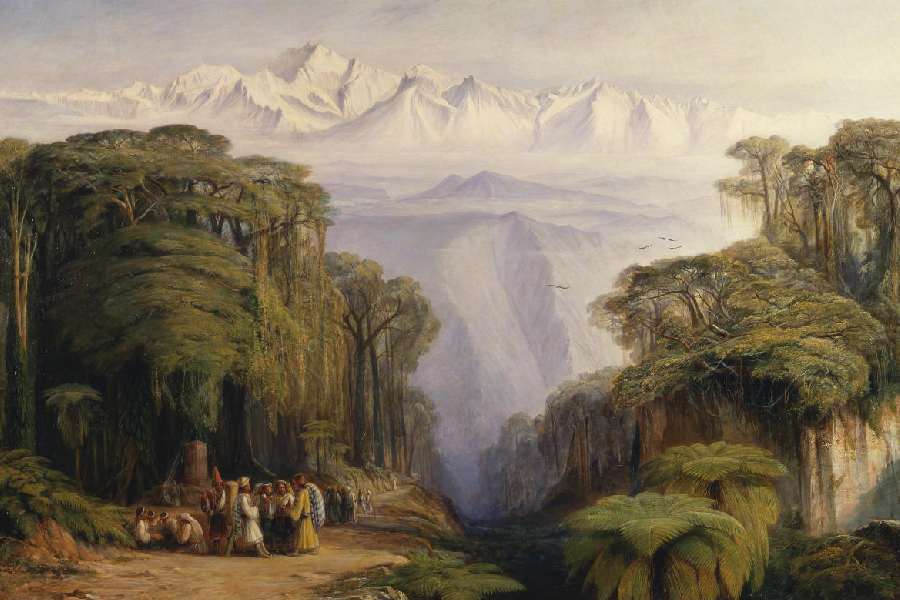Book: THE VICEROY'S ARTIST: A NOVEL
Author: Anindyo Roy
Published by: Hachette
Price: Rs 599
Anindyo Roy’s book painstakingly recreates the endeavours of the painter-poet, Edward Lear, to immortalise the pristine beauty of the Kanchenjunga on canvas. Enthused by the unpublished journals of Lear, The Viceroy’s Artist reconstructs the artist’s erstwhile, relatively unexplored, stays in India between 1873-75. To Roy, these journals served as a revelation of sorts, further paving the way for his fictional exploration. As an expert on the picturesque landscape, the purpose of Lear’s trip to India was to capture the majestic splendour of the Kanchenjunga for the personal collection of Thomas Baring (Lord Northbrook). What, however, sets Roy’s fictionalised retelling apart is his nuanced exploration of Lear’s ingenious mind at work under strenuous circumstances.
Roy’s narration of Lear’s experience and travels throughout India brilliantly captures the colonial times of the British raj. The contemporary reader is bound to be transported to a quirky, bygone world of slow, clanking Indian trains, sluggish “bone-rattling pony carts”, the hustle and bustle of coolies and porters, the sway of presumptuous babus, the quiet engagement of persevering gardeners, the assiduity of the kitmutgars (male attendants), kamsamahs (house stewards/ butlers) and the steady yet uncommunicative punkahwallahs (attendants operating the indigenous fan with a pulley system). Roy’s minute delineation of visual details enhances the intrinsic appeal of the novel, as we spontaneously participate in Lear’s travels across the subcontinent — be it exhausting, dusty train rides across central and eastern parts of India or being hand carried in a jampan (an indigenous mode of transport consisting of a sedan with two horizontal poles carried by porters, especially in the hill towns of northern India). The conditions of most of the journeys undertaken were onerous and demanding: “It had taken nearly four weeks, mostly by train, to travel from Bombay to Calcutta.” Subsequently, Lear’s exhausting journey from Calcutta to the dak bungalow at Kurseong’s Weathercock Point consumed three long days, taking a toll on his health. In fact, most of his journeys across unfamiliar Indian towns in the novel evoke a profusion of indelible images, some even grotesque by nature: “Traversing the belly of India, diagonally, so to speak, and stopping in quaint towns before arriving in Banaras, where he swore he saw bloated corpses floating down the Ganges.”
Navigating through Lear’s sojourns in the novel, the reader is bound to gain an intimate picture of the artist-poet — often regaling children and entertaining families — notwithstanding the moments of artistic solitude or those enduring the rigours of his prolonged journeys. Roy’s fictionalised exploration of Lear’s interactions seems remarkably authentic, especially the one he shares with his accompanying Albanian manservant, Giorgi Kokalis, who served him from 1856 to 1883. Lear’s exchanges with diverse characters across the subcontinent also frequently allude to a wide range of other significant personalities of his time: Franklin Lushington, Lady (Countess) Waldergrave, Chichester Fortescu, Joseph Hooker, Holman Hunt, Alfred Tennyson, Maharajah Duleep Singh and Lockwood Kipling, to mention a few.
Saurav Roy’s eloquent illustrations at the commencement of each chapter, encapsulating relevant vignettes from Lear’s life and works, further augment the pictorial appeal of the work. Laced with an impeccable sense of humour and an eye for detail, The Viceroy’s Artist is bound to strike a chord with all readers interested in travel and the art and culture of the colonial era. Readers, however, would have benefitted from the inclusion of a glossary explaining the vernacular words (bakri, baksheesh, sadhu, ayahs and so on) used in the novel.










